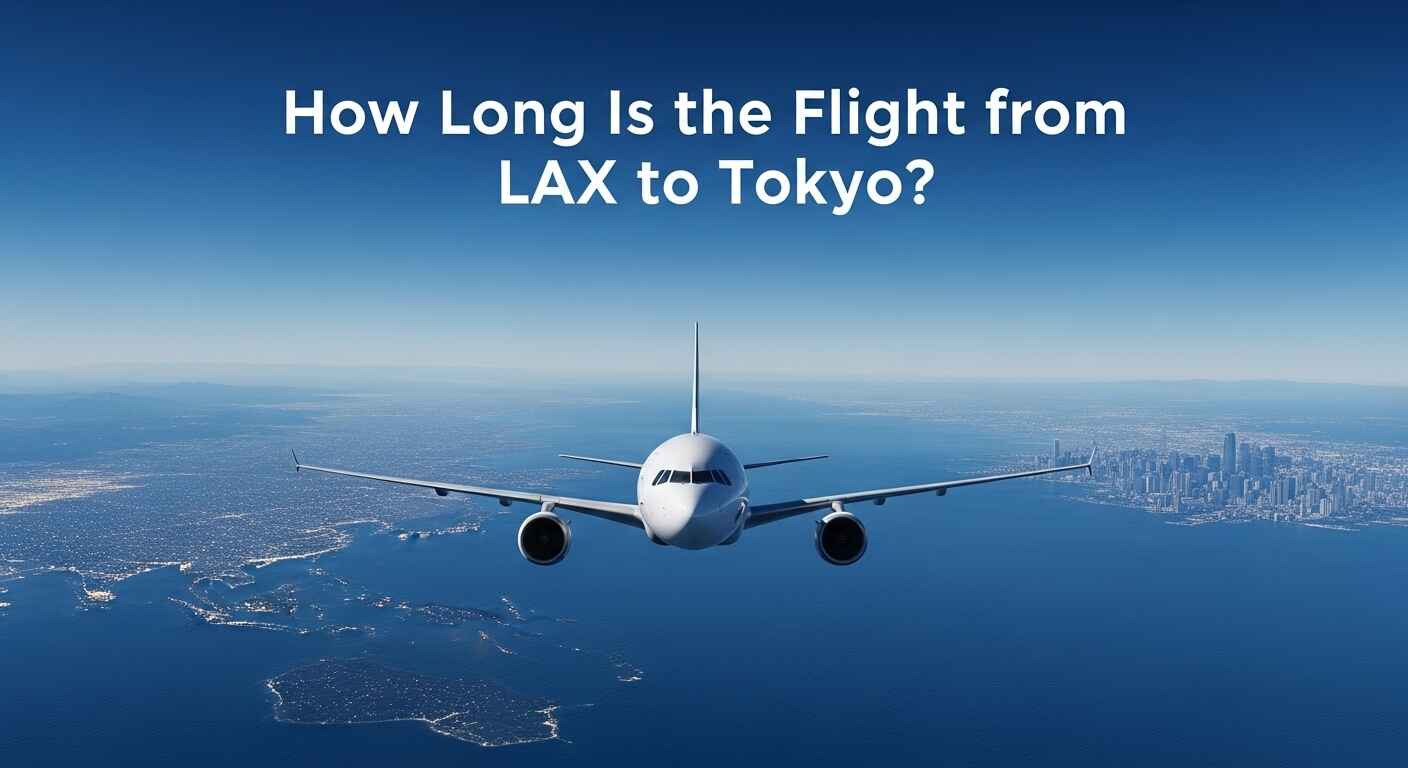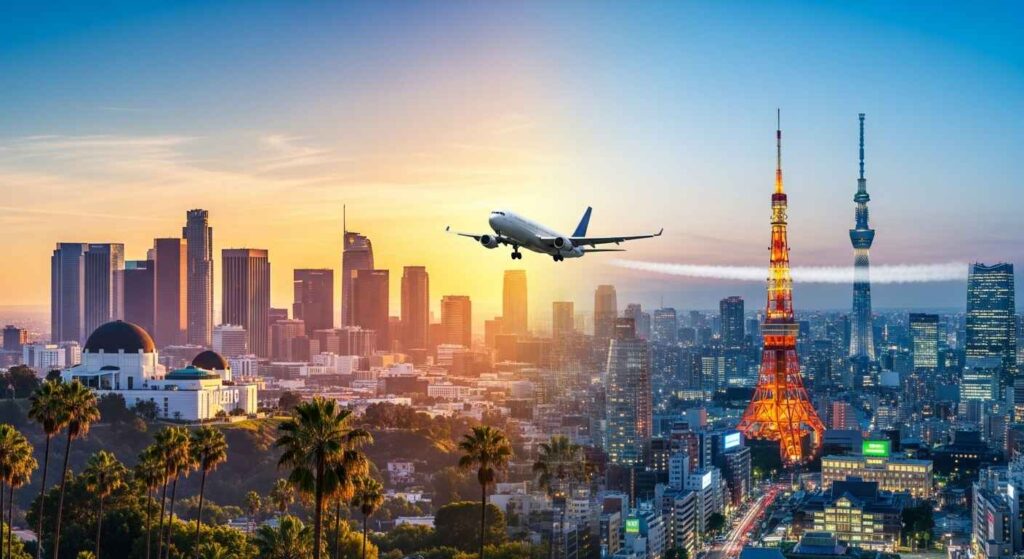
How Long Is the Flight from LAX to Tokyo?
Flying from Los Angeles to Tokyo is a true long-haul, but it’s also one of the most predictable trans-Pacific routes. Most nonstop schedules sit right around 12 hours in the air, with small day-to-day changes based on winds and the specific airport you use in Tokyo (Haneda or Narita).
If you choose a one-stop itinerary to save money or earn miles, plan for a longer door-to-door day. Layovers add up fast, so total time often stretches to 14–18+ hours. The tips below help you set the right expectations, pick the best airport, and arrive fresher.
Quick facts you can trust
- Typical nonstop time: ~11:45–12:10
- Common 1-stop time: 14–18+ hours (layover length is the big factor)
- Tokyo airports: HND (Haneda) and NRT (Narita)
- Distance range: ~5,436–5,488 miles (NRT on the lower end, HND on the higher end)
- Service level: Multiple daily and weekly flights across several airlines, varying by season
What actually sets your flight time
Winds at cruising altitude (the jet stream)
High above the Pacific, a fast “river of air” moves from west to east. When you fly LAX → Tokyo, you face headwinds that slow your ground speed. When you fly Tokyo → LAX, you get tailwinds that help you go faster. This is the main reason the return often looks shorter on the clock.
Airport choice (HND vs NRT)
LAX–HND and LAX–NRT are similar distances. Most days, the airborne time differs by only a few minutes. Pick based on schedule, fare, and where you’ll stay in Tokyo. Haneda is closer to central Tokyo, so your door-to-door time can be shorter even if the flight time is almost the same.
Season
Jet streams shift through the year. Winter can bring stronger headwinds on the westbound leg to Japan. Airlines pad their schedules for this, so you still see a stable range around 12 hours for nonstops.
Operational details
Taxi times, departure queues, minor reroutes, and holding patterns can add minutes. Airlines publish “block times” to cover these normal changes.
Nonstop vs. connecting: which wins?
Nonstop (LAX → HND/NRT)
- Time: ~11:45–12:10 on many days
- Why it wins: No layover risk, less fatigue, simpler plan
- When to choose: If the price is close to a one-stop, the saved hours and energy are worth it.
One-stop (via SFO/SEA/ICN/TPE, etc.)
- Time: usually 14–18+ hours end-to-end
- Why it can make sense: Lower fares, alliance miles, a preferred aircraft or cabin, or a better departure time
- What hurts: Long or awkward layovers balloon the total time quickly
HND vs. NRT: what changes for you
In the air: Flight times are close. On most timetables, both routes hover around ~12 hours, nudged by winds and daily schedules.
On the ground: Haneda sits much closer to central Tokyo. Trains and buses from HND reach many neighborhoods faster than those from NRT. If you value a quick ride to the city, HND helps. If you find a better fare or timing into NRT, go for it—your airborne time won’t be dramatically different.
How far is LAX from Tokyo?
- LAX → NRT: about 5,451 miles (8,773 km)
- LAX → HND: about 5,488 miles (8,831 km)
These are great-circle distances—the shortest paths over the earth’s surface—so actual flight paths may curve to follow favorable winds.
Real-world times you’ll see on Airlines Sites:
When you check airline sites and route directories for upcoming dates, you’ll usually see:
- Nonstop block times clustered near ~12 hours (a few minutes under or over, depending on the day and season)
- Tokyo → LAX often posting slightly faster times than LAX → Tokyo (tailwinds vs headwinds)
- Weekly frequency that shifts by season; several airlines operate LAX–Tokyo nonstops to either HND or NRT
Why westbound feel longer?
The jet stream generally flows west-to-east. Flying against it from LAX to Tokyo means more headwind and a lower ground speed, so the clock runs longer. Flying with it from Tokyo to LAX means tailwind and a higher ground speed, so you shave minutes. It’s wind, not engines or time zones, that makes the difference.

Best time of day to fly this route
- Daytime departures from LAX land in Tokyo the next afternoon or evening. If you prefer to stay awake on board and sleep soon after landing, this pattern fits.
- Overnight departures help some travelers sleep on the plane and roll into a hotel bed soon after arrival.
- If you’re connecting flight: Aim for a 90–150 minute layover on a single ticket. Shorter can work at efficient hubs, but it raises risk if there’s a delay.
How to arrive fresher on a 12-hour flight
- Pick the right seat. If you’re tall, study pitch and layout for your aircraft. An aisle, bulkhead, or exit row can help a lot.
- Pack a “first-night” kit. Eye mask, earplugs, toothbrush, facial wipes, a light tee, and any meds.
- Move and hydrate. Stand, stretch, and walk the aisle every few hours. Drink water.
- Eat light. You sleep better and feel better after landing.
- Plan your arrival. Pre-book an airport train or bus. Check the hotel check-in time to avoid a long lobby wait.
What makes a connection worth it?
You might accept a one-stop if:
- The price gap is big. If the nonstop costs a lot more, a clean connection can be fine.
- You need alliance miles. Chasing status or upgrades can drive the choice.
- You want a specific cabin or plane. A one-stop may unlock a nicer seat or layout.
- You prefer a certain arrival time. Sometimes a connection lines up better with hotel check-in or a meeting.
If the fare is close, nonstop almost always wins on comfort and total time saved.
Door-to-door time: a quick reality check
“Flight time” is only part of your travel day. Add:
- LAX pre-flight: transit to the airport, check-in, security, and boarding buffer
- Taxi time: both ends can add 10–30 minutes
- Immigration and bags: expect extra minutes if several long-hauls arrive together
- Tokyo ground time: HND is closer to the city; NRT is farther. Factor in rail or bus time and any rush-hour delays
This is why two flights with the same airborne time can feel very different in real life.
Example travel day (to set expectations)
You pick a noon departure from LAX with a scheduled 12-hour block. Pushback runs a few minutes late, and the taxi takes 20 minutes. Stronger headwinds slow you a bit in cruise. You land in Tokyo near 4:30 PM local time and reach the gate around 4:45 PM. Your airborne time is about 11h 50m; block-to-block is about 12h 35m. Those extra minutes come from the taxi and the wind. This pattern is normal on long-haul routes.
Simple comparison: nonstop vs. connecting
Nonstop (LAX → HND/NRT)
- Time: ~11h 45m–12h 10m
- Best for: Cutting stress and saving hours
- Choose it when: Price is close to 1-stop, or you value sleep and arriving fresher.
- What changes it: Winds and minor day-to-day schedule tweaks
One-stop (via SFO/SEA/ICN/TPE, etc.)
- Time: ~14–18+ hours total
- Best for: Lower fare, miles with a chosen alliance, or a preferred aircraft/cabin
- Choose it when: You need a specific airline, want to break the trip, or spot a big price gap.
- What changes it: Layover length and airport efficiency
Bottom line
If you want the fastest and simplest trip, book a nonstop from LAX to Tokyo and plan on about 12 hours in the air. If you go with a one-stop to save money or chase miles, budget 14–18+ hours door-to-door and aim for a short, reliable connection. Winds over the Pacific move the numbers a bit, but this simple rule holds year-round.
FAQs
How many hours is a direct flight from LAX to Tokyo?
Most days it sits around ~11 hr 45 min to ~12 hr 10 min. Schedules shift slightly with the season and the winds.
Is Haneda faster than Narita?
In the air, not by much—times are very close. On the ground, Haneda is nearer to central Tokyo, so your door-to-door time can be shorter after landing.
Why is Tokyo → LAX often quicker?
Tailwinds from the jet stream push you along eastbound and trim the clock.
How far is LAX from Tokyo?
About 5,436–5,488 miles, depending on whether you fly to Narita (NRT) or Haneda (HND).
Which airlines fly nonstop?
Several major carriers fly LAX–Tokyo nonstop to HND and NRT. Availability varies by season, so check your exact dates.
What’s the fastest time I might see?
Some schedules show just under 12 hours on certain days. Real times still depend on winds and air traffic conditions.
All Categories
Recent Posts
How Long Is the Flight from LAX to Tokyo?
Atlanta to New York Cheap Flights, Airlines, Prices & Travel Tips 2025
How Long is the Flight from the UK to Turkey?
Tags





